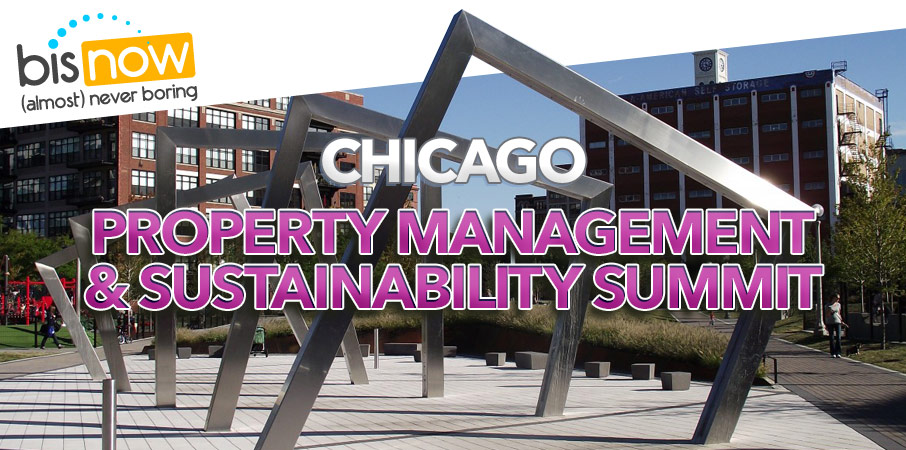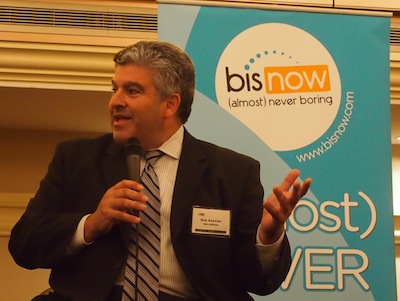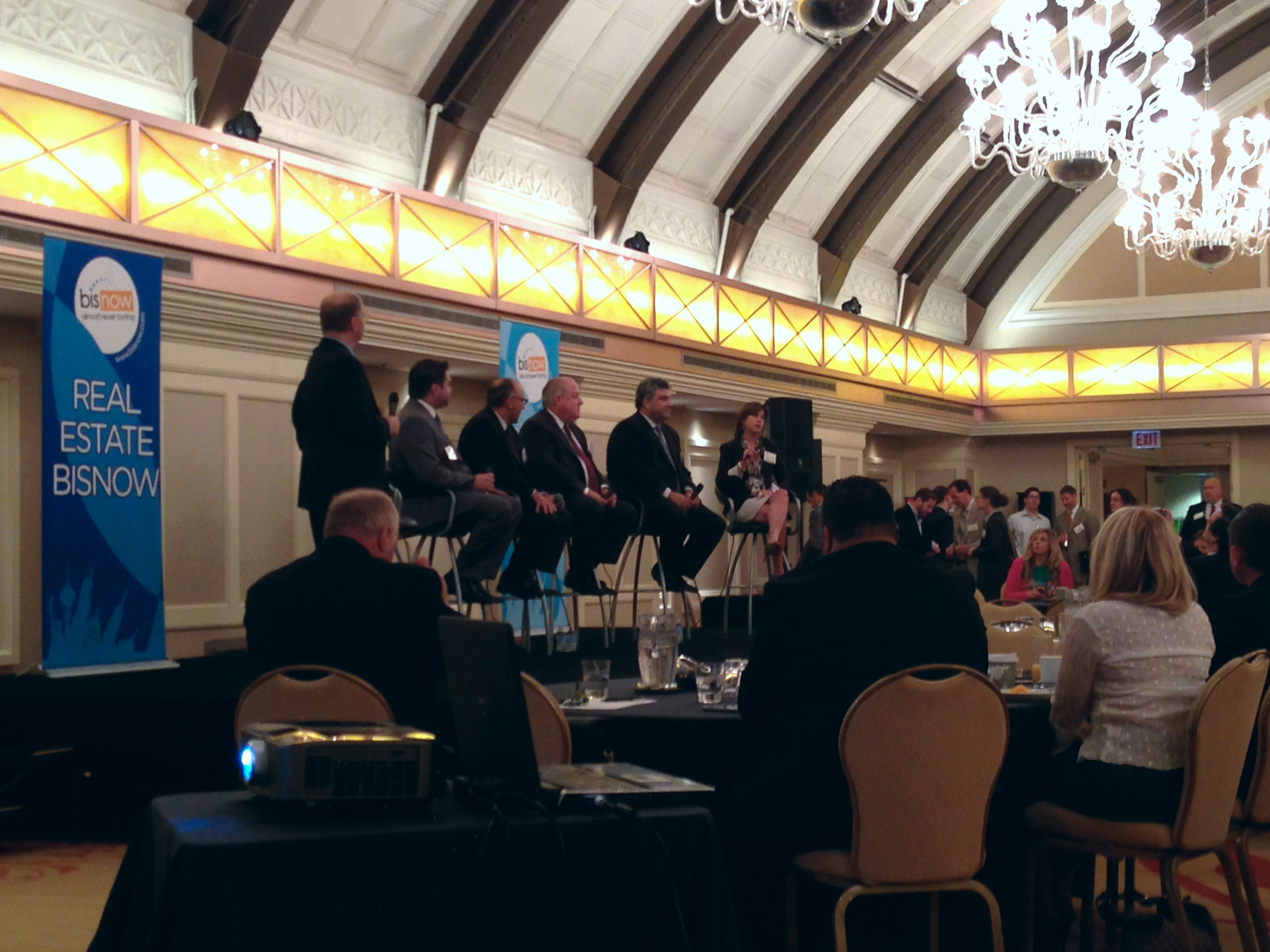August 2013
Bisnow’s Chicago Property Management & Sustainability Summit

This morning we attended Bisnow’s Chicago Property Management & Sustainability Summit to listen to what industry experts, including Bob Assoian, have to say about the challenges, opportunities, efficiencies and sustainability efforts in property management in the city and suburbs. Below is a recap from each panel:
Sustainability Panel
Nathan
Snydacker – Environmental Systems Design (ESD)
Colin
Rohlfing – HOK
Dustin
Gellman – Green per Square Foot
Karen
Weigert – City of Chicago
Steve Boyach – Laramar Group
8:08 AM –
Weigert: We are always adding daily improvements, most recently being transportation
like Divvy bikes and updates to the CTA. First we want more businesses here to
build a stronger economy. Long term, we have the 2015
Sustainable Chicago Program that launched to establish Chicago as a
sustainable economy and help companies adopt sustainable practices.
8:09 –
Rohlfing: At a certain point you can do retrofits, but you can only get to a
certain level of efficiency. There’s no way to drive efficiency without a great
occupant communication plan. If you don’t engage the occupants, you’re never
going to drive the building farther than just the upgrades.
8:10 –
Gellman: If you haven’t heard yet about the
Chicago Green Office Challenge, it’s a plan to get tenants engaged in green
activity. There are currently about 500 companies playing the challenge and
it’s not the type of firms you’d expect. It’s a great resource to get tenants
engaged, since it may not be on the forefront of their mind.
8:12 –
Snydacker: From my perspective, we’re not looking for a total overhaul. It’s a
question on how do we improve what we have?
8:20 –
Weigert: There are a lot of buildings in the city making structural and tenant
educational changes, which is what we are really looking for as a start.
8:25 –
Boyach: A lot of these tasks may seem daunting since they are huge projects to
take on with lots of people. For my team, we put tools in place to help them
make a decision. We’ve put sustainable guidelines in the field to help, such as
telling them the right light bulbs to buy, appliances, quantities to purchase
and what areas have the best incentives or rebates. It’s easy to say “it’s
expensive, what’s the benefit?” But once you take the leap, close the gap to
reach the benefit, it’s worth it.
8:30 –
Gellman: Let’s talk free money—there’s actually a lot of it out there. ComEd
has a new program out this year for small businesses…what we’re doing is going
out and getting all the information about lights in older buildings and ComEd
will fund 75% of the upgrades to lighting and controls. We are working to make
this cost to tenants go from 25% to 0%.
8:35 –
Rohlfing: As a designer, we’ve gotten free money back too…on new construction, if
we need support for an energy model, we can have the utility provider show us
that these things will be efficient, and we will get a check cut to us.
8:38 –
Snydacker: We recently had a project where we signed up for a lighting
incentive and were given $30K back…which was met with skepticism since we’re
not use to getting money returned so easily, that’s an example of the return on
investment with a small change.
8:40 – Weigert:
[On how Chicago is progressing with its plan vs. other cities] Quite simply,
when you think Chicago and sustainability, it’s intertwined. We know the long-term
direction we need to go and it’s a very integrated plan that touches all
aspects of the city…Method, the green cleaning company, came in to build a
manufacturing facility on the South Side in Pullman. They’re strengthening our
economy and reflecting sustainability back on it. We are elevating the
competitiveness of the city. We know changes are happening, like how people
under the age of 30 aren’t buying cars like they use to. We are accommodating
to that by creating better work environments downtown and in the neighborhoods;
they can get there from the El or Divvy bikes.
Property Management Panel

Bob Assoian – NAI Hiffman
Don Shapiro – Foresite Realty Partners
Lenny
Sciascia – Tishman Speyer
Vince Zuppa – Prologis
Bob Six – Zeller Realty Group
Yvonne Jones – McCaffery Interest
8:53 AM –
Sciascia: [On creativity & uniqueness]: Sustainability has been a unique differentiator
for our firm. Our focus is: what are the tenants looking for and what do the
investors want to see? We are doing everything we can to be on the forefront of
sustainable buildings.
8:55 –
Zuppa: We have 3 initiatives in property management in Chicago, first being the
rollout of LED lighting. The payback depends on the
region…we are also spending time finding a light shade that tenants are
used to rather than the common bright-white LED shade. Secondly, we are working
on the fit and finish of our properties. Lastly, in Chicago, we have 6 building
engineers driving around using SageQuest , a GPS fleet
management software, to track their starts, stops and idling time to create a
strategic plan on how they are getting to their properties.
8-57 – Six:
The biggest challenge for us is, finding how to deliver consistent product
while keeping our company unique. Technology is moving fast and the commercial
real estate industry hasn’t been a great adapter, so engaging with young people
to get involved is helping. 150+ years from now, this is a terrifying thought,
but I think offices will be obsolete.
9:00 –
Assoian: Our main job is to take care of the client; on a daily basis we are
looking for ways to wow them and differentiate ourselves. It’s an ongoing challenge
for a firm of our size to keep changing our tools and procedures to offer
clients the product they want.
9:09 –
Shapiro: Does the traditional property manager today manage a building
differently in suburbs vs. downtown?
9:10 – Zuppa:
Yes, obviously there are differences. The different municipalities we have
buildings in require different skill sets from the property manager.
9:11 – Six:
In downtown Chicago, we made 401 N. Michigan a closed building since it’s so
iconic…we would never do something like that in the suburbs.
9:15 – Assoian:
The trend is for young professionals to be downtown, but there is still life in the suburbs—it’s
not nearly as bad as people would think it is. Our first challenge is
convincing institutional clients that the suburbs are not dead. As far as our
job as a property manager, we look at making our buildings more friendly to the
users…we’re renovating conference rooms, adding Wi-Fi lounges, delis and soft
seating so we can compete against the downtown buildings. With the
collaborative workspace trend, we are looking for less “I” space and more “we”
space, if you can offer the upgraded amenities, there are ways to get people in
the suburbs. At some point, the rent difference will be so significant between
downtown and the suburbs which will be a major factor to bring people there.
9:17 – Assoian: One issue we
are seeing is parking, that’s something you don’t see downtown with people
taking the train to work. Metra does have a vanpool program in the suburbs though
to bring downtown people from the train onto a van or car to take from the train
station, to work, to lunch and back. We’ve seen a lot of suburban tenants utilize that to bring downtown people out here, it’s subsidized by tax dollars and is
a program that a lot of people don’t know about yet.
9: 19 –
Shapiro: For a graduate straight out of college, is there a long-term future in
property management?
9:20 –
Jones: I think it’s a great industry. Property Management is the only area in
real estate where you get experience in finance, development, accounting,
marketing, and more. I don’t think there is any other discipline in real estate
that gets that wide, large view of an asset. In 15-20 years from now, you may
want to hone in on something specific, but I think it’s a great first job since
you’re exposed to so many tasks.
9:25 –
Shapiro: Would you say that the property manager is the captain of the ship?
9:26 – Six:
It’s more that they’re the CEO of the building. On top of that, you need to
constantly reinvent yourself and make yourself more valuable to your
organization. You need to invest in yourself to move forward in the
organization. Some of the best leasing people in the industry have a property
management background.



